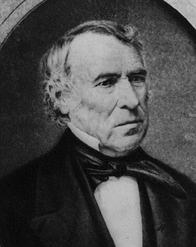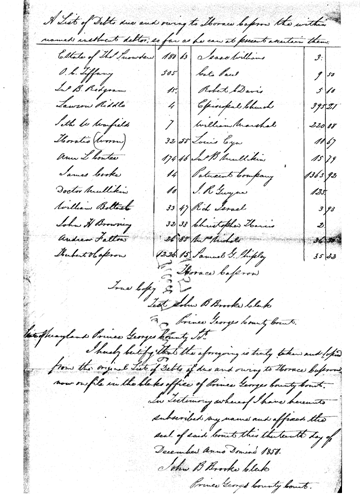The Laurel Years
1835-1850

June 5, 1834 Horace Capron married Louisa V. Snowden daughter of the late Nicholas Snowden and Elizabeth Snowden. Louisa was raised at Montpelier, a former plantation which is today located on what is now Route 197, approximately 3.5 miles from the Laurel Museum. The Snowden family had extensive land holdings, including land on the Patuxent River on which a small cotton factory, originally a grist mill, had been operating.His marriage to Louisa brought Horace land to contribute to a new manufacturing venture in which he would be an owner rather than employee.
The Patuxent Manufacturing Company.
The Patuxent Manufacturing Company was officially chartered by the State of Maryland in June, 1835. Its cotton mill, lands, houses, stores, machine shop and road down to the newly opened B&O Rail stop became the foundation for today's Laurel.
Horace Capron was related to most of his new partners. This was common practice in 19th C. manufacturing. Partners in the new venture included Capron, Theodore Jenkins, his brother-in-law, (married to Juliana Snowden), mother-in-law Elizabeth Snowden, O.C. Tiffany (a first cousin of Horace Capron), A.E. Hall, and W.C. Shaw. Deeds for property and stock for the new venture were signed by Jenkins, Capron, Osmond Tiffany and Comfort Tiffany, also Capron cousins, who were involved in a variety of Mill ventures in Maryland. Osmond Tiffany's son George P. Tiffany was mill superintendent from 1857-1877.
The Patuxent Manufacturing Company.
The Patuxent Manufacturing Company was officially chartered by the State of Maryland in June, 1835. Its cotton mill, lands, houses, stores, machine shop and road down to the newly opened B&O Rail stop became the foundation for today's Laurel.
Horace Capron was related to most of his new partners. This was common practice in 19th C. manufacturing. Partners in the new venture included Capron, Theodore Jenkins, his brother-in-law, (married to Juliana Snowden), mother-in-law Elizabeth Snowden, O.C. Tiffany (a first cousin of Horace Capron), A.E. Hall, and W.C. Shaw. Deeds for property and stock for the new venture were signed by Jenkins, Capron, Osmond Tiffany and Comfort Tiffany, also Capron cousins, who were involved in a variety of Mill ventures in Maryland. Osmond Tiffany's son George P. Tiffany was mill superintendent from 1857-1877.
An Orderly Village
During Horace Capron’s time in Laurel as head of the Patuxent Manufacturing Company, Laurel experienced a period of major growth. He expanded the cotton factory and employed up to 700 workers—many of them women. He was a partner in the creation of the Avondale Mill, just downstream from the Patuxent Factory, and the Laurel Machine Company on Main Street. He also built homes for the workers.
He and his wife Louisa helped build St. Philips Episcopal Church, and he contributed to the creation of St. Mary of the Mills, and the Methodist Church.
He set the tone for the community. And, at a time when there was no public education in Maryland, and the few existing schools required fees, he provided a free education for his workers’ children.
[Col. Capron] has erected 50 blocks of two story stone and brick houses ….To each there is attached a vegetable garden in the rear, with a beautiful yard in front, tastefully laid out in parterres of choice flowers….Col. Capron has erected a school house..here the children receive their education gratuitously.” American Farmer, July 1848.
His influence included settling all disputes, and having complete oversight over his tenants—including their ability to easily imbibe!
“As the whole population were tenants at will, for what tenements within a circuit of a mile or more did not belong to me individually belonged to the Corporation…there was not a grog shop or place for the sale of spirituous liquors permitted which may account for the generally orderly character of the village.” HC Autobiography p. 68.
 Charter of the Prince George's County
Agricultural Society
Charter of the Prince George's County
Agricultural Society
Agriculture: Birth of a Lifelong Passion
During his time in Laurel Horace Capron first developed an intense interest in agriculture and farming. Capron owned a 1200 acre farm in Laurel—including land in the Howard District--in addition to the property devoted to manufacturing.
He bred prize-winning cattle. (He was particularly fond of the Devon & Durham breeds) and was a founder of the Prince George’s Agricultural Society. Publications like American Farmer spotlighted his achievements. He spent large sums on farming—more than $9,000 for fertilizer alone from 1841-47.
“Col. Capron of Prince George’s County, exhibits Devon Bull Eclipse, which took the first prize last year.." American Farmer, quoted in HC Autobiography p. 71
"These and the younger portion of Col. Capron's stocks was probably the largest and most valuable herd ever exhibited by one breeder in the United States..” American Farmer, quoted in HC Autobiography p. 71.
During his time in Laurel Horace Capron first developed an intense interest in agriculture and farming. Capron owned a 1200 acre farm in Laurel—including land in the Howard District--in addition to the property devoted to manufacturing.
He bred prize-winning cattle. (He was particularly fond of the Devon & Durham breeds) and was a founder of the Prince George’s Agricultural Society. Publications like American Farmer spotlighted his achievements. He spent large sums on farming—more than $9,000 for fertilizer alone from 1841-47.
“Col. Capron of Prince George’s County, exhibits Devon Bull Eclipse, which took the first prize last year.." American Farmer, quoted in HC Autobiography p. 71
"These and the younger portion of Col. Capron's stocks was probably the largest and most valuable herd ever exhibited by one breeder in the United States..” American Farmer, quoted in HC Autobiography p. 71.

A Monumental Cornerstone
Horace Capron, who was then a member of the Maryland Militia, attended the laying of the Washington Monument Cornerstone on July 4, 1848. The monument would not be completed until February, 1885 after construction was interrupted during the Civil War.
 President Zachary Taylor
President Zachary Taylor
A Presidential Visit
President Zachary Taylor visited Laurel in July, 1849. His visit was supposed to be a vacation, but he was discovered by the press, and office seekers descended on the town. Taylor visited Capron's farm and the mill. The community threw a Grand Ball in his honor in the Assembly Rooms, attended by Laurel's leaders and mill workers
"Turning to me he [the President] remarked...that he understood...he was to meet the operatives of the place....I assured him that every individual present...he had witnessed the day before engaged in some part of the work he had inspected. " Horace Capron Autobiography p. 74.
President Zachary Taylor visited Laurel in July, 1849. His visit was supposed to be a vacation, but he was discovered by the press, and office seekers descended on the town. Taylor visited Capron's farm and the mill. The community threw a Grand Ball in his honor in the Assembly Rooms, attended by Laurel's leaders and mill workers
"Turning to me he [the President] remarked...that he understood...he was to meet the operatives of the place....I assured him that every individual present...he had witnessed the day before engaged in some part of the work he had inspected. " Horace Capron Autobiography p. 74.
 Inscription on Louisa's Gravestone
Inscription on Louisa's Gravestone
Leaving Laurel
Horace Capron's life and fortunes suffered major setbacks starting around 1849. Louisa died March 27, 1849, at the age of 37. She was buried in the Snowden family cemetery, along with an infant son Nicholas, who had died in 1836. Horace was was left a widower with 5 children: Horace Capron Jr., Albert, Osmond, Adeline, and Elizabeth. It is possible that his sister, Louisa Kirwan Thiers, who was living in Laurel at the time, helped care for the family.
She and her husband moved to Laurel around 1848 and lived there until 1850. She later moved to Wisconsin and lived to be 111 (!) years old.
Economic Disaster
Horace also faced economic disaster. Prices of his stocks fell. His debts increased. Was it because of the economic recession? Mismanagement? Overextension of his agricultural interests--or all three?
"The primary cause of my troubles...was no doubt the result of an over weening confidence in my abilities for overcoming every obstacles that came in my way...The commendation of the press of the whole country had confirmed it." Horace Capron Autobiography p. 78
Capron became an "Insolvent Debtor" and lost all his possessions, his manufacturing and his agriculture properties. He and his family left Laurel, though it would be years before his affairs were completely settled.
Horace Capron's life and fortunes suffered major setbacks starting around 1849. Louisa died March 27, 1849, at the age of 37. She was buried in the Snowden family cemetery, along with an infant son Nicholas, who had died in 1836. Horace was was left a widower with 5 children: Horace Capron Jr., Albert, Osmond, Adeline, and Elizabeth. It is possible that his sister, Louisa Kirwan Thiers, who was living in Laurel at the time, helped care for the family.
She and her husband moved to Laurel around 1848 and lived there until 1850. She later moved to Wisconsin and lived to be 111 (!) years old.
Economic Disaster
Horace also faced economic disaster. Prices of his stocks fell. His debts increased. Was it because of the economic recession? Mismanagement? Overextension of his agricultural interests--or all three?
"The primary cause of my troubles...was no doubt the result of an over weening confidence in my abilities for overcoming every obstacles that came in my way...The commendation of the press of the whole country had confirmed it." Horace Capron Autobiography p. 78
Capron became an "Insolvent Debtor" and lost all his possessions, his manufacturing and his agriculture properties. He and his family left Laurel, though it would be years before his affairs were completely settled.



